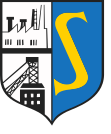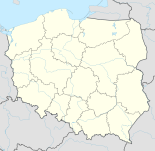Stąporków
| Stąporków | ||
|---|---|---|

|
|
|
| Basic data | ||
| State : | Poland | |
| Voivodeship : | Holy Cross | |
| Powiat : | Końskie | |
| Gmina : | Stąporków | |
| Area : | 10.94 km² | |
| Geographic location : | 51 ° 8 ' N , 20 ° 33' E | |
| Residents : | 5820 (December 31, 2016) | |
| Postal code : | 26-220 | |
| Telephone code : | (+48) 41 | |
| License plate : | TKN | |
| Economy and Transport | ||
| Street : | DR42 | |
Stąporków is a town and seat of the town-and-country municipality of the same name in the Powiat Konecki of the Świętokrzyskie Voivodeship in Poland .
geography
Stąporków is located in the northwest of the Świętokrzyskie Mountains on the upper reaches of the Czarna Konecka River , a tributary of the Pilica . Droga krajowa 42 runs through the city . In addition, it is touched by the single-track, electrified and no longer served by passenger rail line Łódź – Dębica (route number 25).
history
The history of the city goes back to the middle of the 16th century. It is connected with the early ironworks that formed part of the Staropolski Okręg Przemysłowy (Old Polish Industrial Region). In the years 1738 to 1739 the Grand Chancellor of the Polish Crown Jan Małachowski (1698 to 1762) had a blast furnace built. In 1791 Count Friedrich Wilhelm von Reden , a mining and smelting pioneer, visited the city. In 1838 the ironworks was expanded and enlarged by replacing the old blast furnace with two new ones. The ironworks was expanded from 1876 to 1895. It remained in operation until 1938 , even after being damaged in the First World War . The buildings were destroyed in fighting at the end of World War II. After the war, the steel industry was rebuilt. In 1961 the iron foundry employed 1,100 people. The city's population rose from 700 to 3,472 between 1946 and 1961. In 1967 Stąporków were granted city rights. In the late 1960s, a health center, high school and sports hall opened.
From 1975 to 1998 the city was part of the Kielce Voivodeship .
Personalities
- Karol Badyna (* 1960), Polish sculptor


